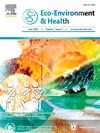Association of greenness with incidence of cardiovascular disease in China: Evidence from the China Kadoorie Biobank prospective cohort study with 0.5 million adults
引用次数: 0
Abstract
Prospective evidence on the relationship of greenness with cardiovascular disease (CVD) incidence is limited in low- and middle-income countries. In 512,691 participants of the China Kadoorie Biobank cohort across 10 regions in China, we calculated the levels of greenness exposure based on satellite-retrieved Normalized Difference Vegetation Index (NDVI) data. Annual maximum NDVI (NDVImax) values were estimated within 500 m and 1000 m buffers around the locations for the participants during the follow-up periods. Record linkages to healthcare databases provided incidence data of total CVD, ischemic heart disease and stroke during 2005–2017. Time-varying Cox proportional hazards regression was used to assess the associations between greenness exposure and CVD incidence. After 5.08 million person-years of follow-up, 148,032 incident CVD events were recorded. The overall average level of NDVImax was 0.543 for all participants. We observed significant inverse associations of greenness with the incidence of CVD and its subtypes. Specifically, the hazard ratio for total CVD incidence was 0.976 (95% confidence interval: 0.958, 0.994) per 0.1 increase in NDVImax within a 500 m buffer. As the 5 rural regions have achieved the WHO recommended greenness goal values, we compared the greenness levels in the 5 urban regions with the WHO's goal for greenness and found that, on average, 3.81% of total CVD incidence might be averted if the recommended greenness values could be achieved. Exposure to a higher level of greenness was associated with a lower risk of CVD incidence in Chinese adults.

绿色与中国心血管疾病发病率的关系:来自中国嘉道理生物库的50万成年人前瞻性队列研究的证据
在低收入和中等收入国家,关于绿化与心血管疾病(CVD)发病率关系的前瞻性证据有限。基于卫星反演的归一化植被指数(NDVI)数据,研究人员对中国10个地区的512,691名中国嘉里生物样本库参与者进行了绿色暴露水平的计算。在随访期间,在参与者周围500米和1000米缓冲区内估计了年最大NDVI (NDVImax)值。与医疗数据库的记录链接提供了2005-2017年期间心血管疾病、缺血性心脏病和中风的总发病率数据。时变Cox比例风险回归用于评估绿化暴露与心血管疾病发病率之间的关系。经过508万人年的随访,记录了148032例CVD事件。所有参与者的NDVImax总体平均水平为0.543。我们观察到绿度与CVD及其亚型的发病率呈显著的负相关。具体而言,在500 m缓冲区内,NDVImax每增加0.1,CVD总发病率的风险比为0.976(95%可信区间:0.958,0.994)。由于5个农村地区已达到WHO推荐的绿化目标值,我们将5个城市地区的绿化水平与WHO的绿化目标值进行了比较,发现如果能够达到推荐的绿化目标值,平均可以避免3.81%的CVD总发病率。在中国成年人中,暴露于较高水平的绿化与较低的心血管疾病发病率相关。
本文章由计算机程序翻译,如有差异,请以英文原文为准。
求助全文
约1分钟内获得全文
求助全文
来源期刊

Eco-Environment & Health
环境科学与生态学-生态、环境与健康
CiteScore
11.00
自引率
0.00%
发文量
18
审稿时长
22 days
期刊介绍:
Eco-Environment & Health (EEH) is an international and multidisciplinary peer-reviewed journal designed for publications on the frontiers of the ecology, environment and health as well as their related disciplines. EEH focuses on the concept of “One Health” to promote green and sustainable development, dealing with the interactions among ecology, environment and health, and the underlying mechanisms and interventions. Our mission is to be one of the most important flagship journals in the field of environmental health.
Scopes
EEH covers a variety of research areas, including but not limited to ecology and biodiversity conservation, environmental behaviors and bioprocesses of emerging contaminants, human exposure and health effects, and evaluation, management and regulation of environmental risks. The key topics of EEH include:
1) Ecology and Biodiversity Conservation
Biodiversity
Ecological restoration
Ecological safety
Protected area
2) Environmental and Biological Fate of Emerging Contaminants
Environmental behaviors
Environmental processes
Environmental microbiology
3) Human Exposure and Health Effects
Environmental toxicology
Environmental epidemiology
Environmental health risk
Food safety
4) Evaluation, Management and Regulation of Environmental Risks
Chemical safety
Environmental policy
Health policy
Health economics
Environmental remediation
 求助内容:
求助内容: 应助结果提醒方式:
应助结果提醒方式:


